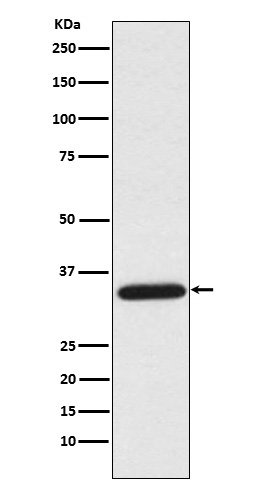
| WB | 1/1000-1/2000 | Human,Mouse,Rat |
| IF | 咨询技术 | Human,Mouse,Rat |
| IHC | IHC:1/100-1/200;IHF:1/50-1/200 | Human,Mouse,Rat |
| ICC | 1/50-1/200 | Human,Mouse,Rat |
| FCM | 1/20-1/100 | Human,Mouse,Rat |
| Elisa | 咨询技术 | Human,Mouse,Rat |
| Aliases | UNG; DGU; HIGM4; HIGM5; Uracil-DNA glycosylase; UNG1; UNG2; UDG; UNG15;;UNG |
| WB Predicted band size | Calculated MW: 35 kDa ; Observed MW: 32 kDa |
| Host/Isotype | Rabbit IgG |
| Antibody Type | Primary antibody |
| Storage | Store at 4°C short term. Aliquot and store at -20°C long term. Avoid freeze/thaw cycles. |
| Species Reactivity | Human,Mouse,Rat |
| Immunogen | A synthesized peptide derived from human UNG |
| Formulation | Purified antibody in PBS with 0.05% sodium azide,0.05% BSA and 50% glycerol. |
+ +
以下是3篇与UNG抗体相关的研究文献概览:
---
1. **"Uracil-DNA glycosylase deficiency impairs antibody class switch and genomic stability in B cells"**
*作者:Di Noia, J.M., et al. (2007)*
*摘要:* 研究证实UNG缺失的小鼠B细胞在抗体类别转换重组(CSR)中存在缺陷,揭示UNG在修复激活诱导胞苷脱氨酶(AID)产生的尿嘧啶损伤中的关键作用,并强调其对抗体多样性和基因组稳定性的重要性。
---
2. **"Structural basis for recognition of repair intermediates by UNG and SMUG1 uracil-DNA glycosylases"**
*作者:Parikh, S.S., et al. (2000)*
*摘要:* 通过X射线晶体学解析UNG蛋白与含尿嘧啶DNA复合物的结构,阐明其特异性识别和切除尿嘧啶的分子机制,为开发靶向UNG的抗体及抑制剂提供结构基础。
---
3. **"Antibody-based inhibition of human uracil-DNA glycosylase suppresses cancer cell proliferation"**
*作者:Kavli, B., et al. (2007)*
*摘要:* 利用单克隆抗体特异性抑制UNG的酶活性,证明其在癌细胞中阻断碱基切除修复(BER)通路可诱导DNA损伤积累,抑制肿瘤生长,提示UNG抗体在癌症治疗中的潜在应用。
---
4. **"UNG-initiated base excision repair is the major repair route for 5-fluorouracil in DNA"**
*作者:An, Q., et al. (2007)*
*摘要:* 通过UNG抗体阻断实验,证实UNG是清除化疗药物5-FU诱导的DNA尿嘧啶损伤的主要修复酶,为优化基于5-FU的化疗策略提供了理论依据。
---
以上研究涵盖UNG在抗体生成、结构解析、癌症治疗及化疗耐药性中的作用,相关抗体多用于功能抑制或机制研究。
The uracil-DNA glycosylase (UNG) antibody is a critical tool in molecular biology for studying DNA repair mechanisms. UNG is a highly conserved enzyme in the base excision repair (BER) pathway, responsible for excising uracil residues misincorporated into DNA during replication or generated via cytosine deamination. This repair activity prevents C→T mutagenesis and maintains genomic integrity. Mammals express two UNG isoforms: UNG1 (mitochondrial/nuclear) and UNG2 (nuclear), with distinct roles in genome maintenance and antibody diversification in B cells.
UNG antibodies are widely used to detect and quantify UNG protein expression, localization, and function in various biological contexts. They enable research into DNA repair dynamics, cancer biology (particularly in tumors with defective repair pathways), and immune system studies, as UNG activity is essential for somatic hypermutation and class-switch recombination in adaptive immunity. Commercial UNG antibodies are typically developed using epitopes from human or mouse UNG sequences and validated for applications like Western blotting, immunohistochemistry, and immunofluorescence. Recent studies also employ these antibodies to investigate UNG's role in viral defense, aging-related genomic instability, and chemotherapy resistance. Quality validation remains crucial due to potential cross-reactivity with other glycosylases in the BER pathway.
×